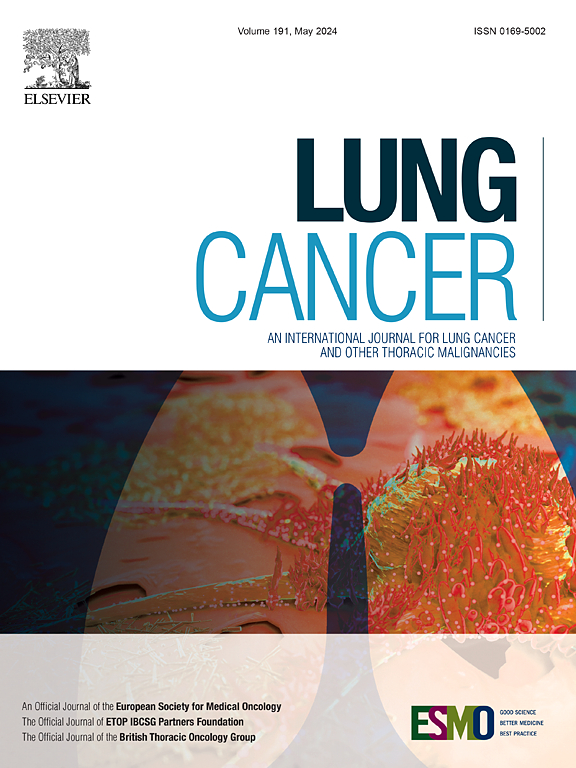Polygenic risk score to define risk of cancer-associated thrombosis among patients with lung cancer in a population-based study
IF 4.4
2区 医学
Q1 ONCOLOGY
引用次数: 0
Abstract
Background
Venous thromboembolism (VTE) is a major complication in lung cancer, and remains challenging to predict with current risk models. This study assesses the utility of a Polygenic Score (PGS) for VTE risk stratification in lung cancer patients.
Methods
Analyzing UK Biobank data with 3,241 lung cancer patients, we explored the association between a high PGS, with and without positive monogenic mutations (factor V Leiden [FVL]/ prothrombin gene mutation [PGM]), and VTE incidence. Two definitions of VTE incidence were used: “restricted location VTE” (pulmonary embolism or lower extremity thrombosis) and “any VTE” (inclusive of all venous thromboses).
Results
A high PGS was strongly associated with an increased VTE, including in subgroup analysis with adjustment for comorbidities. A previous VTE (Hazard ratio [HR]: 5.5) and metastasis (HR: 2.52) predicted increased risk of VTE. In addition, the top PGS quartile predicted VTE in both the any VTE definition: HR 1.35 (with FVL/PGM) and 1.39 (without FVL/PGM); and in the restricted location VTE: HR 1.38 (without FVL/PGM); all p ≤ 0.05. The 12-month VTE incidence confirmed the predictive discrimination of the PGS regardless of FVL/PGM status.
Conclusion
The PGS identified lung cancer patients at higher inherited risk for VTE, suggesting its potential for personalized prophylaxis and improved clinical outcomes.

在一项基于人群的研究中,多基因风险评分定义肺癌患者癌症相关血栓形成的风险
背景:静脉血栓栓塞(VTE)是肺癌的主要并发症,目前的风险模型预测仍然具有挑战性。本研究评估了多基因评分(PGS)在肺癌患者静脉血栓栓塞风险分层中的应用。方法通过分析英国生物银行(UK Biobank) 3241例肺癌患者的数据,探讨有或没有阳性单基因突变(因子V Leiden [FVL]/凝血酶原基因突变[PGM])的高PGS与静脉血栓栓塞发生率之间的关系。静脉血栓栓塞发生率有两种定义:“限制性位置静脉血栓栓塞”(肺栓塞或下肢血栓形成)和“任何静脉血栓栓塞”(包括所有静脉血栓形成)。结果高PGS与VTE升高密切相关,包括在调整合并症的亚组分析中。既往静脉血栓栓塞(危险比[HR]: 5.5)和转移(危险比[HR]: 2.52)预示着静脉血栓栓塞的风险增加。此外,在任何VTE定义中,前PGS四分位数预测VTE: HR 1.35(有FVL/PGM)和1.39(没有FVL/PGM);受限位置VTE: HR 1.38(无FVL/PGM);p均≤0.05。无论FVL/PGM状态如何,12个月的静脉血栓栓塞发生率证实了PGS的预测性区分。结论PGS识别出具有较高VTE遗传风险的肺癌患者,提示其具有个性化预防和改善临床结果的潜力。
本文章由计算机程序翻译,如有差异,请以英文原文为准。
求助全文
约1分钟内获得全文
求助全文
来源期刊

Lung Cancer
医学-呼吸系统
CiteScore
9.40
自引率
3.80%
发文量
407
审稿时长
25 days
期刊介绍:
Lung Cancer is an international publication covering the clinical, translational and basic science of malignancies of the lung and chest region.Original research articles, early reports, review articles, editorials and correspondence covering the prevention, epidemiology and etiology, basic biology, pathology, clinical assessment, surgery, chemotherapy, radiotherapy, combined treatment modalities, other treatment modalities and outcomes of lung cancer are welcome.
 求助内容:
求助内容: 应助结果提醒方式:
应助结果提醒方式:


